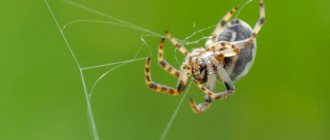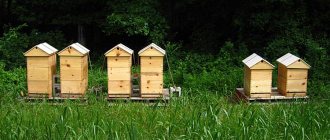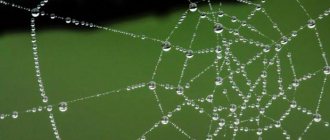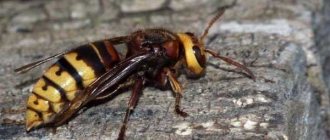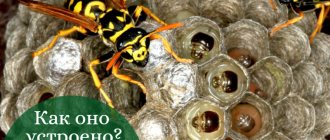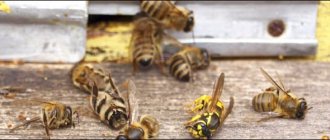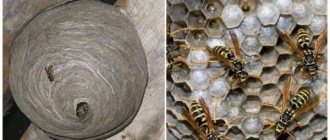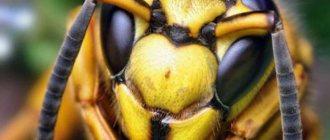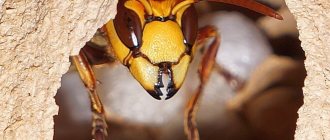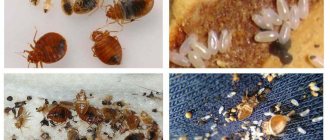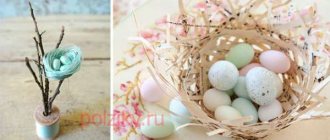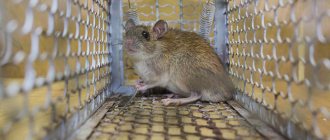How to find a wasp's nest
Finding insect habitats is not always easy. This is due to the fact that wasp hives can be located in a variety of places:
- underground in empty mouse holes;
- on branches and in the hollows of old trees;
- in basements and attics of residential premises.
Only a thorough inspection of the utility rooms located in the house and apartment will help you find a hive.
Wasps are in constant search of food for the larvae growing in their nest. The desire to feast on sugary substances attracts insects to people’s homes, especially during the period of making jam. They do not disdain meat scraps from human food.
Vespiary
If it is not possible to determine the presence of a nest visually, and the presence of insects bothers you, then you should leave fruit or pieces of meat in a visible place. By observing where the uninvited guests take their prey, it will most likely be possible to determine their permanent location.
The size of the constructed hive can range from the diameter of a tennis ball to a basketball, and in some cases larger. Regardless of the location, the wasp hive is built in the form of a horizontal structure, the cells of which face downward with their entrances.
Important! When trying to destroy a wasp's nest, do not stand directly under it, otherwise an angry swarm of wasps will fall right on the head of its offender.
If during the search a wasp nest was discovered in the initial stage of construction, then measures must be taken to eliminate it as quickly as possible. This is due to the very fast pace of work of the insect. Sometimes a new house grows right before the eyes of people amazed at the speed of its appearance.
Fighting methods
To get rid of a wasp nest on a plot of land, it is filled with boiled water or doused with a flammable substance and set on fire. The procedure is performed late in the evening, when all family members are gathered and are going to spend the night, or early in the morning, when they have not yet had time to fly away.
When placing the hive under the roof of a house, in an attic, or in a tree, the nest is immersed in water. Fill the bucket, bring it carefully to the wasp’s nest, and immerse it in water. Another modern way to get rid of pests is using a vacuum cleaner. They pull the insects into the bag at full speed, then throw them into the water.
To prevent the construction of nests, repellent plants are planted on the land - mint, lemon balm, marigolds, calendula. The walls are treated with an insecticidal substance, paint, varnish, and boric acid solution.
What do wasps make their nests from?
Hornets nest
Note! Unlike bees, wasps do not have the ability to produce wax, so they build a home from small pieces of wood they come across.
Nature compensated for the inability to secrete wax by giving the wasps jaws. With their help, insects scrape pieces of rotten wood, and then glue the resulting mass with the liquid produced during chewing. Wood chips, bark and even sawdust are used. The construction material obtained in this way can be compared in appearance to wrapping paper. For this skill, the insects received the name “paper wasps.”
The walls of the internal cells have a denser and smoother structure. The layers of the outer sphere of the structure under construction look quite loose. Wasps that live in the tropics use everything they find to create their hives: limestone pieces, clay grains of sand, and, if necessary, manure.
There are several thousand species of wasps, each of which adapts to environmental conditions in its own way. Habitat features greatly influence what wasps use to make a hive.
What do wasps make their nests from?
The largest species of wasps, hornets, use young tree bark for construction. From the outside, a hornet hive looks like a large bucket, and in cross-section, the cells of the nest are colored yellow-brown, sandy or brown.
Construction material
The finished wasp nest is nothing short of impressive. From the outside it looks like a smooth, oval-shaped egg. Inside, numerous honeycombs are found, arranged in a certain way. The building material resembles ancient parchment. Mostly gray, brownish in color. Because of the way wasps build their nests, they are called paper wasps. The family is one of the most numerous and includes species and subspecies.
What wasps make nests from and how building materials are obtained also deserves respect. The insect lands on wood, spits out a certain amount of its own secretion, under the influence of which the upper tissues of the tree bark liquefy. The wasp grabs the top layer with its powerful jaws and pulls it towards itself, as if scraping it off. When she has the amount she needs, she goes to a place where other relatives are making a hive.
Having arrived at the right place, the wasp once again carefully chews the building material with its jaws. Under the influence of saliva, the wood becomes sticky, stringy, gray or brown, depending on what tree it was extracted from. The wasp spits the finished building material onto the already formed honeycombs, again stretches it with its jaws, giving its structure an oval shape. This is how a new thin partition appears.
Interesting!
The wasp obtains woody elements from the bark of various trees, stumps, fences, and wooden outbuildings. If there is not enough building material or the queen finds a place suitable for raising larvae, the wasps build a nest underground, in old stumps, hollows, left by bird houses.
How wasps build a nest
Bee's nest
Construction of the nest occurs in stages:
- Construction begins in the spring. The female, who managed to survive the winter, prepares a place for breeding future offspring. To do this, she constructs several cup-shaped cells. Due to their shallow depth, one egg is laid in each cell. The female is responsible for the life support of the larvae, obtains food for them and carries out feeding.
- As they grow, the larvae increase in size. The female, as necessary, builds walls for the growing offspring. Within a month, a metamorphosis occurs, transforming the egg laid by the uterus into a pupa, which in turn transforms into an adult.
- The first insects to appear are females that are not capable of reproduction and play the role of building maintenance workers. Now they build up the walls of the partitions, creating new cells for eggs, which the female continues to lay. Feeding the growing larvae is also the responsibility of these hard-working, but incapable of procreating insects.
- July is a turning point in the life of the wasp family, living on several floors of a house under construction, filled with cells of different sizes.
- By the end of summer, the largest compartments are occupied by hatched females, awaiting the appearance of males. Wasps of different sexes have external differences: males lack a sting, but have mustaches that are larger than those of females.
- Along with the passing summer months, the life of the male population of the hive, as well as the worker wasps and the old queen, ends. Construction stops.
- During this period, grown-up young females leave their summer home and find cozy and warm crevices in which they will wait for the arrival of spring.
- Next spring, each of the fertilized wasps will become a queen and begin building a new home in which to lay future offspring.
Construction process
A fertilized young female, the queen, chooses a place for her future home. It glues an adhesive substance extracted from wood to the base, stretches it, and a leg is formed, on which the first honeycombs are subsequently built. Initially there are very few of them; they are necessary for growing and feeding the larvae.
The process begins in early spring. Within a month, a new generation of worker wasps appears and begins active construction of the hive. The uterus sheds the powers of an architect and is engaged only in the reproduction of offspring.
- The hornet's nest is being built at an accelerated pace, since the number of members of the large family is rapidly increasing. New cells appear at the base of the handle, which overlap each other to form a honeycomb.
- As the number of cells increases, a bowl-shaped structure begins to emerge. Over time, it increases in depth, expands on all sides, and becomes like a sphere. There is a hole in the center for entry.
- The construction of the second part of the sphere gradually begins. The number of cells decreases towards the top. The finished large wasp nest resembles a cocoon.
After construction is completed, the queen removes several layers of internal cells in the first sphere. As the wasps make the honeycombs wider, the space inside is freed up. The outer shell of the nest is thin and papery. It is formed from long, thin, elastic plates. In most cases, recycled building material is used, which is taken after the inner layers of the hive have been destroyed.
How many wasps in one nest
How to destroy a hornet nest
Depending on the size of the house, a huge number of insects, sometimes numbering in the hundreds of thousands, can comfortably live in it.
Wasps are distinguished by a variety of species of individuals living in interaction in one house. Females, males and working insects have different structures and external differences that are noticeable even to a non-specialist. Each group strictly fulfills the duties prescribed by nature. Differences within one species are called polymorphism, or multiformity. The bulk of the residents are working individuals, which are concentrated around the queen, who continues to lay new eggs.
How many wasps in one nest
Nutrition
Wasps are predatory insects, although they are known to have a “sweet tooth.” You should not leave bowls of jam on the summer veranda after drinking tea; wasps will certainly discover this gift and fly here for a new portion. Wasps can lick nectar from flowers, or they can also snack on smaller insects.
And yet, one has only to remember the wasp-rider, and doubts about predation will disappear. This wasp looks for a well-fed caterpillar, sits astride it (like an equestrian), pierces the skin with its ovipositor and lays eggs in the body of the victim.
Later, the larvae will be provided with food, that is, this very caterpillar. Some wasps choose beetles instead of caterpillars. The Pepsis wasp (road wasp) even tracks spiders, attacking them, sometimes even in their own home, and lays its eggs in the body of this spider.
By the way, cicadas, which are larger than wasps, also feed the larvae. They are simply walled up in a cell with an egg and when the larva hatches, it will not starve.
How long do wasps live in a nest?
After the wasps have built a nest, the life cycle of the wasp family lasts one summer. The life of the hive, which began in the spring, reaches its climax by mid-summer and continues while construction is underway. By the beginning of autumn, all life processes calm down and stop. The established order is unchanged and requires annual new buildings.
Last year's hives are not relevant for a wasp swarm, but if the location chosen for construction is well located, the insects will build another home within walking distance of last year's house.
Important! Wasps can return to their favorite places even after their home is destroyed. Therefore, it is necessary to treat the area where the hive is located with special substances designed to combat and destroy these insects.
Features of some types
Varieties of paper specimens are black and yellow in color. The nests are round and can be found in the attics of buildings and the walls of various buildings. Nests are made from paper produced by the individuals themselves.
The flower wasp is a very small creature, its size reaches no more than 1 cm. They feed on pollen and nectar of various flowers. The flower wasp builds a nest from sand and clay, holding them together with its saliva.
The largest representative of the family is the hornet. Its length can reach 55 mm. Parasitic wasps include glitterweeds. These bright and shiny individuals are accustomed to living on other bees and butterflies. Sand wasps dig holes in the ground to live in. Road views do the same. The food for the larvae is spiders and insects, paralyzed by the poison from the sting of adults.
This insect belongs to the order Hymenoptera
The German wasp is interesting because its females and males differ from each other quite noticeably. Males are large in size, small females have no wings at all and look more like ants. These ants are often called velvet ants because their bodies are covered with fluff.
Scolias look very beautiful. These are insects up to 10 cm long. They look more like butterflies.
Black wasp Typhia. They often settle on the body of the cockchafer. Sometimes they burrow into the ground in search of beetle larvae.
When wasps leave their nests
Every hive has guard wasps. When danger approaches, they give a special signal, thanks to which a large number of irritated insects instantly emerge from the nest, ready to defend their possessions.
Despite the fact that the wasp's venom does not pose a critical danger to humans, its bite is quite painful. The most powerful and unpleasant bite for humans is a hornet bite.
Important! A distinctive feature of all wasps is the ability to sting several times in a row. Due to its structure, a wasp sting does not get stuck in the skin of a person or animal.
Close proximity to a wasp nest can ruin not only the mood of people living nearby, but also their health. Therefore, having discovered a hive, it is necessary to take decisive measures to destroy it. With quick and precise movements, crush the hive with your hand or, if possible, your foot.
Attention! Having decided to destroy a nest, you need to protect your body, especially your face and hands, with clothing that can protect you from bites.
Character and lifestyle
The character of striped predators is quite bad, that is, frankly aggressive. At the slightest disturbance, this insect attacks first. The wasp not only stings, but also bites the enemy, although bites with the mouth are much less noticeable than working with a stinger.
If there is another wasp nearby, sensing the smell of poison, it will rush to help the attacking wasp. And woe betide the one who disturbs the hornet’s nest. Then a whole cloud of wasps will fly out to protect their home and the culprit will be very unlucky.
At the same time, wasps are very caring nannies and mothers, although this applies mainly only to social wasps; in solitary wasps, the mother’s care is expressed only in providing the larva with paralyzed prey - they provide their larvae with food for a long time during their development. In social wasps, caring for their offspring is much more difficult.
Each wasp in the family goes through all the “working” stages. If at first a young individual can only be a cleaner, then with age she is “promoted” to the rank of wet nurse.
Wasps find their nest unerringly, even when they fly many kilometers away from it. But if the nest is moved even a few meters, finding its home will be a very difficult task for this insect.
How far do wasps fly from the nest?
Social insects are “attached” to their home. Wasps fly away from it only during the day, preferring to spend the night at home. This is the time that is considered the most favorable for spraying wasp nests with pesticides to kill insects.
When wasps leave their nests
Wasps fly out to a distance of no more than 100 meters from the dwelling they have built. Two reasons force people to leave their native walls:
- search for food;
- danger of nest destruction.
Lifespan of a worker bee
Worker bees are female creatures; due to their physiological characteristics, they lack the ability to reproduce. It is from them that the majority of the bee colony consists. They perform many functions:
- collect nectar and pollen from flowers;
- deliver water for the entire bee family;
- build honeycombs;
- clean the hive;
- create the necessary microclimate;
- protect their home;
- serve queens, drones, and larvae.
How long a worker bee lives is influenced by many factors:
- climatic conditions of the habitat;
- time period of the brood (season of the year);
- intensity, amount of work performed;
- nutrition;
- wintering conditions.
The lifespan of a worker bee largely depends on the time of birth. An individual born in the spring can live up to 35-40 days. A summer bee (June bee) may live up to 30 days. Autumn ones live longer - up to six months or a year.
Who destroys wasps' nests
In addition to people who do not like living next to wasps, their houses are often destroyed by wild animals and birds. It is especially common to see tits pecking at last year’s wasp’s nest.
Wasp nests can become a source of discomfort and irritation for those whose home they choose as their place of stay. Therefore, it is better to take preventive measures in advance to avoid an inconvenient and burdensome neighborhood.
5 1 vote
Article rating
Precautionary measures
Methods of dealing with wasps, as already noted, can be quite dangerous. At the same time, wasps often get out of their nests, so you need to know how to kill a wasp if it lands on your body. Don’t worry and don’t move too much: you shouldn’t allow an insect bite. The ideal option would be to use a regular fly swatter, but if you don’t have one at hand, you can try to carefully drive the wasp off your hand and then crush it with something heavy. How to kill a wasp if it flew into your apartment? The actions should be the same, but you should get rid of the insect with a sharp and quick movement. However, this should not be done if you are getting rid of a swarm of wasps. A killed insect releases a special substance that provokes an attack by the entire flock.
Domestic fleas: how to get them out of your apartment
The next precaution is your equipment. Wear long sleeves, thick gloves and a beekeeper mask when working.
